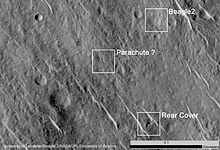Beagle 2
The Beagle 2 was a British Mars lander that was carried to Mars by the European Space Agency's 2003 Mars Express mission. It was an astrobiology mission that was designed to look for past life on the shallow surface of Mars.
 Replica of the Beagle 2 at the Science Museum, London | |
| Mission type | Mars lander |
|---|---|
| Operator | National Space Centre |
| COSPAR ID | 2003-022C[1] |
| Website | www |
| Mission duration | 6 months (planned)[2] |
| Spacecraft properties | |
| Landing mass | 33.2 kg (73 lb) |
| Payload mass | 9 kg (20 lb) science instruments |
| Dimensions | Folded: 1 m diameter Unfolded: 1.9 m diameter Height: 12 cm[3] |
| Power | 60 W[3] |
| Start of mission | |
| Launch date | 2 June 2003, 07:45 UTC |
| Rocket | Soyuz-FG / Fregat |
| Launch site | Baikonur Cosmodrome |
| Contractor | EADS Astrium |
| Mars lander | |
| Landing date | 25 December 2003, 02:45 UTC |
| Landing site | Isidis Planitia, Mars 11°31′35″N 90°25′46″E / 11.5265°N 90.4295°E |
The Beagle 2 was conceived by a group of British academics. It was led by Professor Colin Pillinger of the Open University.
The spacecraft successfully arrived in orbit round Mars on 19 December 2003. It was going to land on the surface of Mars on 25 December. There was no contact at the expected time of landing. ESA declared that the mission was lost in February 2004, after several attempts to contact the spacecraft were unsuccessful.[4]
Beagle 2's fate remained a mystery until January 2015. Then it was found on the surface of Mars by a series of images from NASA's Mars Reconnaissance Orbiter HiRISE camera.[5][6] The images suggest that two of the spacecraft's four solar panels failed to deploy, blocking the spacecraft's communications antenna.
The Beagle 2 was named after HMS Beagle, the ship used by Charles Darwin.

References
change- ↑ "Beagle 2". National Space Science Data Center. NASA. 26 August 2014. Retrieved 22 January 2015.
- ↑ Rafkin, Scot C. Randell; Michaels, Timothy I.; Haberle, Robert M. (January 2004). "Meteorological predictions for the Beagle 2 mission to Mars" (PDF). Geophysical Research Letters. 31 (1). L01703. Bibcode:2004GeoRL..31.1703R. doi:10.1029/2003GL018966. S2CID 10852966.
MGCM results are used to characterize the large-scale atmospheric fields over the primary mission (approximately 180 sols; to Ls ≈ 51).
- ↑ 3.0 3.1 "Technology FAQs". Open University. Archived from the original on 9 April 2004.
- ↑ "Beagle 2 spacecraft found intact on surface of Mars after 11 years". TheGuardian.com. 17 January 2015.
- ↑ Webster, Guy (16 January 2015). "'Lost' 2003 Mars Lander Found by Mars Reconnaissance Orbiter". NASA. Archived from the original on 24 February 2017. Retrieved 16 January 2015.
- ↑ "Mars Orbiter Spots Beagle 2, European Lander Missing Since 2003". New York Times. Associated Press. 16 January 2015. Retrieved 17 January 2015.